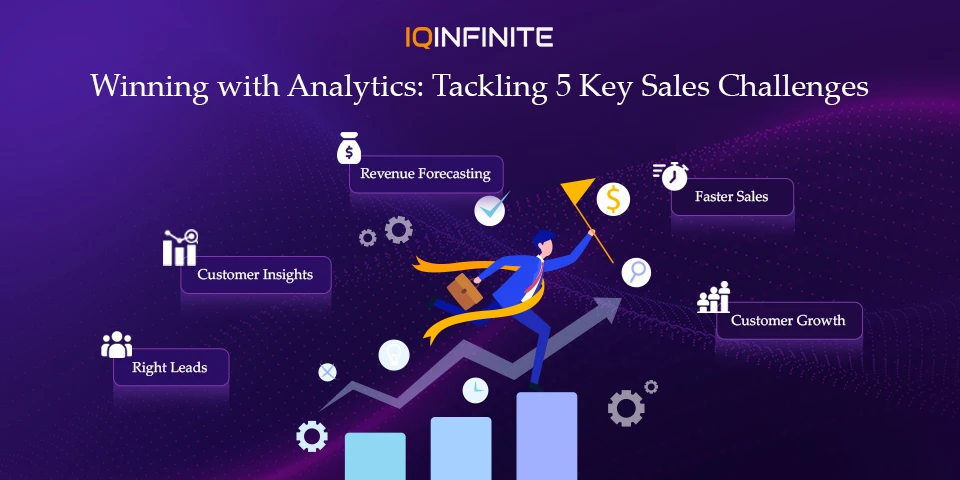Win with Analytics: Overcoming 5 Critical Sales Challenges

In today’s hyper-competitive market, sales success can’t rely on gut feeling alone. The real edge lies in data. Analytics has become the foundation of modern sales strategies helping businesses uncover trends, anticipate customer needs and fine-tune processes to consistently stay ahead.
Yet, many sales teams continue to struggle with obstacles that slow growth and impact performance. The good news? Every challenge is an opportunity when approached with the right analytics strategy. Let’s dive into five of the most critical sales challenges and see how analytics can transform them into drivers of success.
1. Identifying the Right Leads
The Challenge: Sales teams often waste valuable time chasing unqualified prospects, struggling to separate high-potential leads from those unlikely to convert.
The Analytics Advantage: Predictive analytics and lead-scoring models process vast amounts of customer data such as browsing behaviour, purchase history and engagement levels to rank leads by their likelihood to buy. This empowers sales reps to focus their efforts on the most promising opportunities, boosting efficiency and win rates.
The Analytics Advantage: Predictive analytics and lead-scoring models process vast amounts of customer data such as browsing behaviour, purchase history and engagement levels to rank leads by their likelihood to buy. This empowers sales reps to focus their efforts on the most promising opportunities, boosting efficiency and win rates.
2. Understanding Customer Needs
The Challenge: Without deep insights into customer preferences and pain points, reps risk delivering irrelevant pitches or missing opportunities to add real value.
The Analytics Advantage: Customer analytics leverages behavioural data, feedback and interaction history to uncover patterns and preferences. Armed with these insights, sales teams can personalize conversations, propose solutions that truly resonate and build stronger, trust-based relationships.
The Analytics Advantage: Customer analytics leverages behavioural data, feedback and interaction history to uncover patterns and preferences. Armed with these insights, sales teams can personalize conversations, propose solutions that truly resonate and build stronger, trust-based relationships.
3. Shortening the Sales Cycle
The Challenge: Prolonged and complex sales cycles drain resources, slow down growth and increase the chance of losing deals to competitors.
The Analytics Advantage: Sales analytics pinpoints pipeline bottlenecks and identifies which actions accelerate deal progression. For example, data may reveal that sharing case studies early or scheduling product demos quickly shortens conversion time. By replicating proven tactics, teams can close deals faster and more consistently.
The Analytics Advantage: Sales analytics pinpoints pipeline bottlenecks and identifies which actions accelerate deal progression. For example, data may reveal that sharing case studies early or scheduling product demos quickly shortens conversion time. By replicating proven tactics, teams can close deals faster and more consistently.
4. Forecasting Revenue with Precision
The Challenge: Inaccurate revenue forecasts create misaligned targets, poor resource allocation and missed opportunities for scaling.
The Analytics Advantage: Advanced forecasting models draw on historical performance, seasonal patterns and market conditions to deliver more precise predictions. Reliable forecasts enable leaders to set realistic goals, allocate resources effectively and make proactive strategic decisions.
The Analytics Advantage: Advanced forecasting models draw on historical performance, seasonal patterns and market conditions to deliver more precise predictions. Reliable forecasts enable leaders to set realistic goals, allocate resources effectively and make proactive strategic decisions.
5. Retaining Customers and Driving Growth
The Challenge: Acquiring new customers is costly and without the right insights, companies often fail to spot early warning signs of churn.
The Analytics Advantage: Retention analytics tracks customer engagement, satisfaction scores and buying frequency to detect risk signals before it’s too late. With these insights, sales teams can re-engage at-risk clients through tailored offers, proactive outreach and value-driven conversations turning potential churn into long-term loyalty and growth.
The Analytics Advantage: Retention analytics tracks customer engagement, satisfaction scores and buying frequency to detect risk signals before it’s too late. With these insights, sales teams can re-engage at-risk clients through tailored offers, proactive outreach and value-driven conversations turning potential churn into long-term loyalty and growth.
Conclusion
Sales will always come with challenges, but they don’t have to be roadblocks. With the right analytics strategies, every obstacle becomes an opportunity to improve efficiency, build stronger customer relationships and drive consistent growth. From finding the right leads to retaining loyal customers, data-driven insights empower sales teams to act with precision instead of guesswork.
In today’s competitive landscape, relying on intuition alone is no longer enough. Businesses that embrace analytics are not just keeping up they’re staying ahead. The future of sales belongs to teams that transform challenges into victories through the power of data.
In today’s competitive landscape, relying on intuition alone is no longer enough. Businesses that embrace analytics are not just keeping up they’re staying ahead. The future of sales belongs to teams that transform challenges into victories through the power of data.
